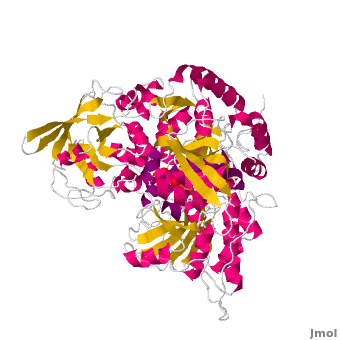Aconitase
From Proteopedia
(Difference between revisions)
(→Catalytic mechanism of mitochondrial ACO) |
(→Catalytic mechanism of mitochondrial ACO) |
||
| Line 6: | Line 6: | ||
== Catalytic mechanism of mitochondrial ACO == | == Catalytic mechanism of mitochondrial ACO == | ||
| - | <applet load=7acn scene='Aconitase/7acn-sf4/1' size='400' frame='true' align='left' caption="Mitochondrial aconitase from pig, PDB [[7acn]]." />The bulk of citrate cycle processing happens in mitochondria and so, studies concentrated on <scene name='Aconitase/7acn-sf4/1'>the mitochondrial ACO</scene>. The <scene name='Aconitase/7acn-sf4-3cys/1'>(4Fe-4S) cofactor is held in place</scene> by three sulfur atoms belonging to the cysteins-385, -448, and -451. | + | <applet load=7acn scene='Aconitase/7acn-sf4/1' size='400' frame='true' align='left' caption="Mitochondrial aconitase from pig, PDB [[7acn]]." />The bulk of citrate cycle processing happens in mitochondria and so, studies concentrated on <scene name='Aconitase/7acn-sf4/1'>the mitochondrial ACO</scene>. The <scene name='Aconitase/7acn-sf4-3cys/1'>(4Fe-4S) cofactor is held in place</scene> by three sulfur atoms belonging to the cysteins-385, -448, and -451 which are bound to three of the four cluster iron atoms. The fourth, Fe4, is free to bind; it can be four-, five-, or six-coordinate, but is constrained to bond to three sulfur atoms of the (4Fe-4S)-cluster with terahedral geometry. Thus, Fe4 is free to bind one, two, or three partners, in this reaction always oxygen atoms belonging to other molecules. As Fe4 is not bound very fast to the cluster, it moves quite a bit around in the process of bonding and debonding. |
<!--It is clear that, in order to synthesize L-isocitrate, stereoselective catalysis must occur.--> | <!--It is clear that, in order to synthesize L-isocitrate, stereoselective catalysis must occur.--> | ||
Revision as of 16:18, 20 February 2009
Aconitase (ACO) is an enzymatic domain that confers the ability to catalyse the equilibrium
- citrate = aconitate + H2O = L-isocitrate
This reaction is part of the citrate (TCA-, Krebs-)cycle.
In most organims, there is a cytosolic enzyme with an ACO domain (cAc), and in eukaryotes, a second copy of it was introduced with mitochondria (mAc). Plants developed even more copies in mitochondria.
Catalytic mechanism of mitochondrial ACO
|
Cytosolic aconitase and its other function
Weblinks
Proteopedia Page Contributors and Editors (what is this?)
Michal Harel, Alexander Berchansky, Ralf Stephan, David Canner, Joel L. Sussman, Jaime Prilusky, Anthony Noles, Angel Herraez, Eran Hodis

